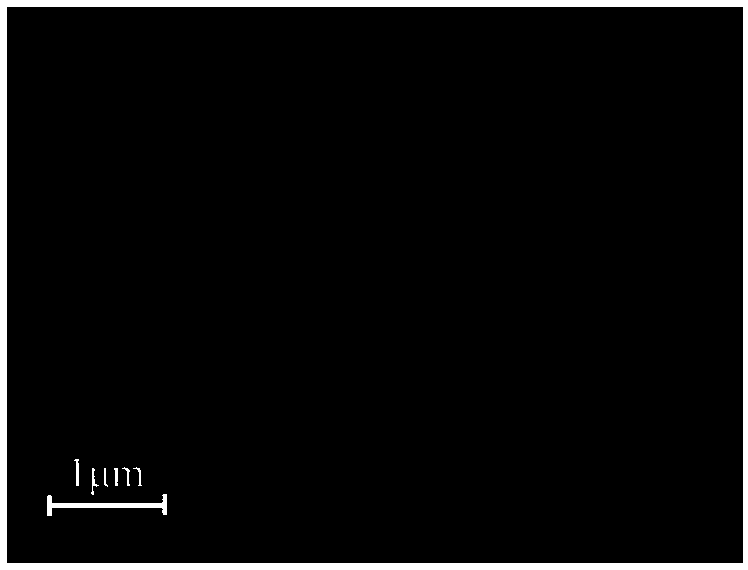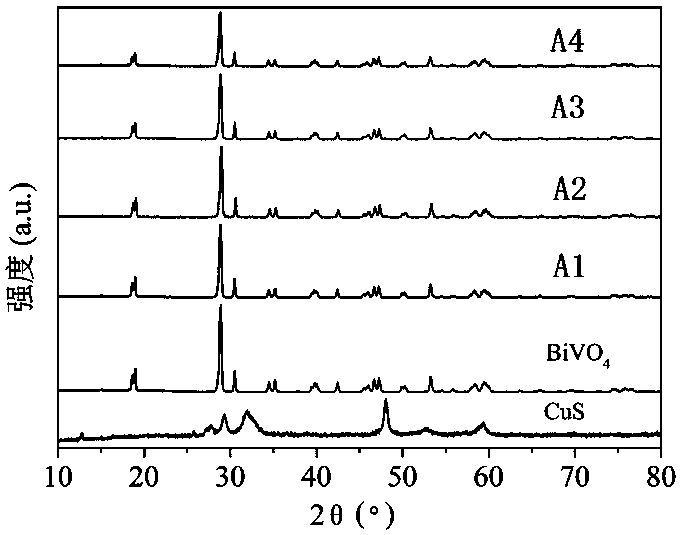Copper sulfide/bismuth vanadate heterojunction photocatalyst and preparation method thereof
A photocatalyst, bismuth vanadate technology, applied in physical/chemical process catalysts, metal/metal oxide/metal hydroxide catalysts, chemical instruments and methods, etc., can solve the problem of narrow visible light absorption range, practical application limitations, impact Solve problems such as copper sulfide formation, achieve strong pollutant degradation ability, wide visible light absorption range, and improve photocatalytic activity
- Summary
- Abstract
- Description
- Claims
- Application Information
AI Technical Summary
Problems solved by technology
Method used
Image
Examples
Embodiment 1
[0039] A copper sulfide / bismuth vanadate heterojunction photocatalyst comprises bismuth vanadate and copper sulfide, and the copper sulfide is attached to the bismuth vanadate to form a heterojunction material.
[0040] In this embodiment, the mass ratio of copper sulfide to bismuth vanadate in the copper sulfide / bismuth vanadate heterojunction photocatalyst is 3:97.
[0041] In this embodiment, the bismuth vanadate is in the form of a block with a thickness of 1 μm to 2 μm; the copper sulfide is in the form of particles.
[0042] A preparation method of the copper sulfide / bismuth vanadate heterojunction photocatalyst of the present embodiment, comprising the following steps:
[0043] (1) Dissolve 6 mmol of bismuth nitrate pentahydrate in 32 mL of nitric acid solution with a concentration of 1 mol / L, and sonicate for 10 min to obtain a bismuth nitrate solution; add 6 mmol of ammonium metavanadate to the above bismuth nitrate solution, magnetic Stir for one hour to obtain a su...
Embodiment 2
[0046] A copper sulfide / bismuth vanadate heterojunction photocatalyst is basically the same as the copper sulfide / bismuth vanadate heterojunction photocatalyst of Example 1, except that the difference is: the copper sulfide / bismuth vanadate heterojunction of Example 2 The mass ratio of copper sulfide to bismuth vanadate in the photocatalyst is 1:19.
[0047] A preparation method of the copper sulfide / bismuth vanadate heterojunction photocatalyst of the above-mentioned present embodiment is basically the same as the preparation method of the copper sulfide / bismuth vanadate heterojunction photocatalyst in the embodiment 1, and the difference is only in that: Example 2. In step (2) of the preparation method, the amounts of copper nitrate trihydrate and sodium thiosulfate pentahydrate are respectively 0.0397g and 0.0408g.
[0048] Preparation of copper sulfide / bismuth vanadate heterojunction photocatalyst in Example 2 (CuS / BiVO 4 ), numbered A2.
Embodiment 3
[0050] A copper sulfide / bismuth vanadate heterojunction photocatalyst is basically the same as the copper sulfide / bismuth vanadate heterojunction photocatalyst of Example 1, except that the difference is: the copper sulfide / bismuth vanadate heterojunction of Example 3 The mass ratio of copper sulfide to bismuth vanadate in the photocatalyst is 7:93.
[0051] A preparation method of the copper sulfide / bismuth vanadate heterojunction photocatalyst of the above-mentioned present embodiment is basically the same as the preparation method of the copper sulfide / bismuth vanadate heterojunction photocatalyst in the embodiment 1, and the difference is only in that: Example 3. In step (2) of the preparation method, the amounts of copper nitrate trihydrate and sodium thiosulfate pentahydrate are respectively 0.0568g and 0.083g.
[0052] Preparation of copper sulfide / bismuth vanadate heterojunction photocatalyst in Example 3 (CuS / BiVO 4 ), numbered A3.
PUM
| Property | Measurement | Unit |
|---|---|---|
| thickness | aaaaa | aaaaa |
Abstract
Description
Claims
Application Information
 Login to View More
Login to View More - Generate Ideas
- Intellectual Property
- Life Sciences
- Materials
- Tech Scout
- Unparalleled Data Quality
- Higher Quality Content
- 60% Fewer Hallucinations
Browse by: Latest US Patents, China's latest patents, Technical Efficacy Thesaurus, Application Domain, Technology Topic, Popular Technical Reports.
© 2025 PatSnap. All rights reserved.Legal|Privacy policy|Modern Slavery Act Transparency Statement|Sitemap|About US| Contact US: help@patsnap.com



